Extra Questions for Class 9 Science Chapter 7 Diversity in Living Organisms
Extra questions for Class 9 Science Chapter 7 Diversity in Living Organisms with answers is given below. Our subject expert prepared these solutions as per the latest NCERT textbook. These questions will be helpful to revise the all topics and concepts. CBSE Class 9 extra questions are the most simple and conceptual questions that are prepared by subject experts for the students to study well for the final exams. By solving these extra questions, students can be very efficient in their exam preparations.
Diversity in Living Organisms Class 9 Science Extra Questions and Answers
Very Short Answer Questions
1: Who wrote the book “The Origin of Species”?
Answer: Charles Darwin in 1859.
2: Who proposed the classification of organisms into 5 kingdom?
Answer: Robert Whittaker (1959).
3: Define species.
Answer: All organisms that are similar to breed and perpetuate.
4: Give example of the organism belonging to Monera and Protista Kingdom.
Answer: Monera—Anabaena, blue-green algae
Protista—Eugleno, Paramecium, Amoeba
5: Name the appendages used for movement by organism belonging to Protista kingdom
Answer: Paramecium – Cilia
Euglena – Flagella
Amoeba – Pseudopodia
6: What is lichen?
Answer: The symbiotic association of fungi and blue-green algae, is called lichen.
7: What is symbiotic relationship?
Answer: It is a relationship between two organisms in which both of them are benefitted, e.g., fungi gets food from blue-green algae and in return blue-green gets shelter [lichens].
8: What is saprophytic nutrition?
Answer: The organisms using dead and decaying organic matter as food are said to show saprophytic nutrition.
9: Give simple classification of plant kingdom.
Answer:
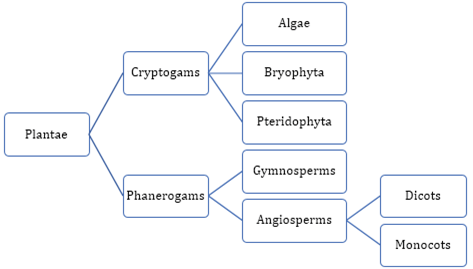
10: Name the plant amphibian.
Answer: Bryophyta e.g. Funaria (Moss).
11: What are cryptogamae?
Answer: The plants with inconspicuous reproductive organs are called cryptogamae, e.g., fern.
12: Give examples of pteridophyte.
Answer: Marsilea and Fern.
13: Name the reproductive organ of plants.
Answer: Flower.
14: What are gymnosperms?
Answer: The group of plants that bear naked seeds e.g., pines, deodar.
15: What are angiosperms?
Answer: The group of plants with covered seeds are called angiosperms. These are flowering plants.
16: What are cotyledons?
Answer: Plant embryos in seeds have structures called cotyledons. Cotyledens are also known as seed leaves.
17: Name the phylum of an animals with pores on it.
Answer: Porifera e.g., sponge.
18: Name the phylum of Jellyfish
Answer: Coelenterata or Cnidaria.
19: What is the meaning of triploblastic?
Answer: Animals which have three layers of cells from which differentiated tissues -can be made.
20: What is bilateral symmetry?
Answer: When the left and right halves of the body have same design it is called bilateral symmetry.
21: What is the meaning of “cold-blooded animal”?
Answer: Those animals who show the variation in their body temperature according to the surroundings are called cold-blooded animals, e.g., fish, amphibians, reptiles.
22: Name two mammals that lay eggs.
Answer: Platypus and echidna.
23. Name three mammals that live in water.
Answer: Whale, platypus and Dolphins.
24: Name a fish with skeleton made up of cartilage.
Answer: Shark.
25: Name two fish which have skeleton made up of both bone and cartilage.
Answer: Tuna and rohu.
26: Name the reptile with four-chambered heart.
Answer: Crocodile.
Short Answer Type Questions
1: Give the characteristics of Monera.
Answer:(a) Organisms are unicellular, do not have a defined nucleus.
(b) Organisms may‘‘have cell wall or may not have cell wall.
(c) Mode of nutrition is either autotrophic or heterotrophic.
2: Give the characteristics of Protista.
Answer: (a) Organsims are unicellular and eukaryotic.
(b) Use appendages for locomotion like cilia, flagella, etc.
(c) Nutrition is either autotrophic or heterotrophic.
(d) E.g., algae, protozoa.
3: Give the difference between thallophyta and bryophyta.
Answer:
| Thallophyta | Bryophyta |
| Body is thallus like not differentiated into -root, stem. Example: Spirogyra. | Plant Body is differentiated into stem and leaf like structures. Example: Moss. |
4: What are hermaphrodites? Give two examples.
Answer: When an organism has both the sexes, i.e., it can produce both sperms and eggs are called hermaphrodites. Example: Sponges, earthworms.
5: Give the difference between monocots and dicots.
Answer:
| Monocots | Dicots |
| Seeds with one cotyledon. | Seeds with two cotyledons. |
| Leaves have parallel venation. | Leaves have reticulate venation. |
| Root system—fibrous. | Root system—tap root. |
6: Give the difference between two types of symmetry that animals show.
Answer: Symmetry—Bilateral and Radial
| Bilateral Symmetry | Radial Symmetry |
| Any organism that has same design on left and right halves of the body. Example: Earthworm, spider, cockroach. | Any organisms with a body design such that it can be divided into two equal halves from any radius. Example: Starfish sea urchin. |
7: Differentiate between vertebrates and invertebrates.
Answer:
| Vertebrates | Invertebrates |
| Notochord is present. | Notochord is absent. |
| True internal skeleton present. | No true internal skeleton present. |
8: Name the phylum of the following animals:
(a) Tapeworm
(b) Starfish
(c) Jellyfish
(d) Octopus
Answer: (a) Tapeworm – Flatyhelminthes
(b) Starfish – Echinodermatai
(c) Jellyfish – Coelenterata
(d) Octopus – Mollusca
9: Identify the phylum for the following characteristics given:
(a) Organisms with joint appendages.
(b) Organisms are generally flat worms.
(c) Body is segmented.
(d) Skin of organisms is full of spikes.
Answer: (a) Arthropoda
(b) Platyhelminthes
(c) Ann elida
(d) Echinodermata
10: State the features of all chordates.
Answer: All chrodates possess the following features:
1. Have a notochord
2. Have a dorsal nerve chord
3. Are triploblastic
4. Have paired gill pouches
11: Give general characteristics of Porifera.
Answer: (a) Animals with pores all over the body.
(b) Body is not well differentiated.
(c) Non-motile animals, remain attached to solid support.
(d) Body is covered with hard outer skeleton.
Example: sponges.
12: How are pores or holes all over the body of Porifera important?
Answer: The pores or holes present all over the body of the organisms lead to a canal system that helps in circulating water throughout the body to bring in food and oxygen.
13: Give general characteristics of ‘Platyhelminthes’?
Answer: (a) These are flat worms.
(b) Most of them are parasites.
(c) Animals are triploblastic
(d) No true internal body cavity.
Example: Tapeworm, planaria, Liver fluke.
14: Give specific characteristics of Coelenterata.
Answer: (a) Water living animals.
(b) Body is made of two layers of cells.
(c) Some of them live in colonies (corals), while others have solitary life-span {Hydra).
(d) Body cavity present.
15: Give the characteristics of Arthropoda with 2 examples.
Answer: (a) Arthropoda means jointed legs’.
(b) Animals are bilaterally symmetrical and segmented.
(c) It has an open circulatory system.
(d) This is the largest group of animals.
Example: Spider, scorpionts, crabs, house flies.
16: Give the characteristic features of Echinodermata.
Answer: (a) Spikes present on skin.
(b) Free living, marine animals.
(c) Triploblastic and have a coelomic cavity.
(d) Have a peculiar water driven tube system used for moving around.
(e) Have hard calcium carbonate structure that is used as a skeleton.
Example: Starfish, seaurchin.
17: Give the characteristics of mammals.
Answer: (a) Mammals are warm-blooded animals.
(b) Four-chambered heart.
(c) Mammary glands for production of milk to nourish their younger one.
(d) Skin has hairs, sweat glands and oil glands.
(e) Most of them produce their young ones (viviparous).
18: What are the conventions followed for writing the scientific names?
Answer: The conventions followed while writing the scientific names are:
1. The name of the genus begins with a capital letter.
2. The name of the species begins with a small letter.
3. When printed, the scientific name is given in italics.
4. When written by hand, the genus name and the species name have to be underlined separately.
19: Differentiate between algae and fungi
Answer:
| Algae | Fungi |
| Contain chlorophyll (green in colour). | Do not contain chlorophyll (non-green) |
| Autotrophic nutrition. | Heterotrophic nutrition. |
| Food is stored in the form of starch. | Food is stored in the form of glycogen. |
20: Name the phylum of the following organisms, whose exclusive characteristics is given below:
(a) Hollow bones
(b) Jointed appendages
(c) Flat worm
(d) Round worms, parasitic
(e) Soft body, muscular marine animal
(f) Radially symmetrical, spiny skin.
Answer: (a) Phylum chordata, subphylum—vertebrata, class—Aves
(b) Phylum—Arthropoda
(c) Phylum—Platyhelmithes
(d) Phylum—Aschelminthes
(e) Phylum—Mollusca
(f) Phylum—Echinodermata
21: Give the characteristibs of amphibians.
Answer: Amphibians are vertebrates that lives on land and in water.
(a) They are cold-blooded.
(b) Heart is three-chambered.
(c) Fertilization is external.
(d) Respiration through lungs on land and through moist skin when in water.
Example: Frog, Toads
22: Give the characteristics of Aves.
Answer: (a) Aves/birds can fly.
(b) Streamlined body.
(c) Hollow and light bones.
(d) Forelimbs are modified into wings.
(e) Warm-blooded animals, heart with four chambers.
(f) Egg laying animals.
(g) Beak present, teeth are absent.
23: Why do most of the amphibians lay their eggs in water and reptiles lay their eggs on land?
Answer: Amphibians lay their eggs in water because the tadpeles or young, ones that hatch out of egg has gills at initial stages, that allows them; to breathe in water.
In case of reptiles the young ones that hatch out does not have gplls> and the hatching of eggs requires warmth that is given by the mother, reptile.
24: Give the hierarchy of 5 kingdom classification of living world.
Answer:
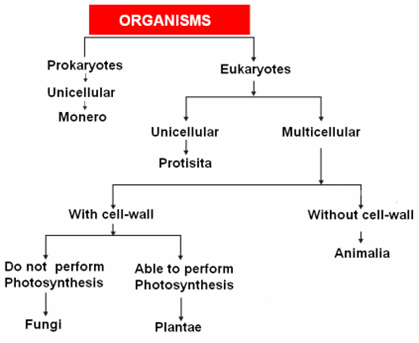
Long Answer Type Questions
1: What is the importance of classification?
Answer: Classification is important because:
(a) Classification makes the study of wide variety, of organisms, systematic and easier.
(b) It projects a picture of all organisms and their interrelation with each other.
(c) It provides a base for the study of other branches of biology.
(d) It is useful in the study of ecology, which deals with; the inter-relation of an organism with their environment.
(e) It helps to establish a hierarchy of groups of organisms.
2: What are the characteristic features of mammals?
Answer: Characteristics features of mammals:
(a) Body is covered with hair.
(b) Skin is provided with sweat and sebaceous glands.
(c) Heart is four-chambered.
(d) Fertilization is internal.
(e) Females have mammary glands to produce milk to nourish their young ones.
(f) External ear—pinna, present.
(g) Eyes have eye lids.
(h) Warm-blooded.
(i) Respiration through lungs,
(j) Body cavity divided’ into- thorax and1 abdomen by muscular diaphragm.
3: What are the characteristic features of reptiles?
Answer: The characteristics of reptiles:
(a) Dry scaly, impermeable skin.
(b) Respiration through lungs.
(e) Cold-blooded
(d) Internal fertilization.
(e) Heart is three chambered’.
(f) Two pairs of pentadactyl limbs are present.
4: What are the basis for classification of organisms?
Answer: The basis for classification are:
(a) Presence or absence of nucleus.
(b) Organisms are unicellular, or multicellular.
(c) Level of organisation.
(d) Autotrophic mode of nutrition or heterotrophic mode of nutrition.
(e) Of the organisms that perform photosynthesis (Plants), their level, or organisation of the body.
(f) Of the animals, how does the individuals body develop and organise its different parts.
5: Give the characteristics of fiat worms, round worms and segmented worm. Give their phylum.
Answer:
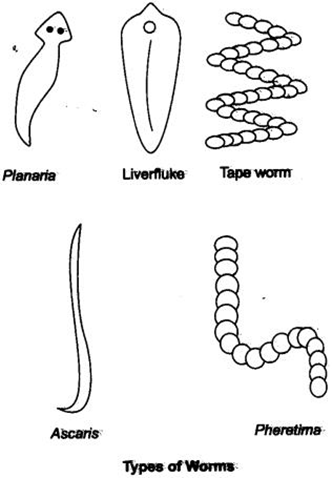
| Flat worms | Round worms | Segmented worms |
| Phylum—Platyhelminthes | Phylum Nematoda | Phylum Annelida |
| Dorsoventrally flat, i.e., flat body from top to bottom. | Body is cylindrical. | Body is segmented from head to tail. |
| No true body cavity. | Pseudocoelom (Sort of body (cavity). | True body cavity. |
| Mostly hermaphrodite, i.e., male and female sex organs present in the same individual. | Sexes are separate. | May be unisexual or bisexual. |
6: Give the classification of plant kingdom.
Answer:
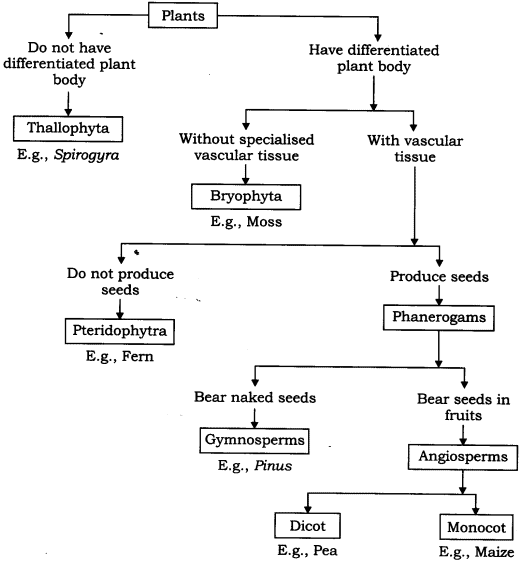
7: Differentiate (5 points) between monocot and dicot plants.
Answer:
| Monocot Plants | Dicot Plants |
| Fibrous root | Tap root |
| Parallel venation | Reticulate venation. |
| Seeds with one cotyledon | Seeds with two cotyledons |
| Vascular bundles are scattered. | Vascular bundles are arranged in rings. |
| Flowers are trimerous | Flowers are pentamerous, flowers or tetramerous |
8: Give the outline classification of animal kingdom.
Answer:
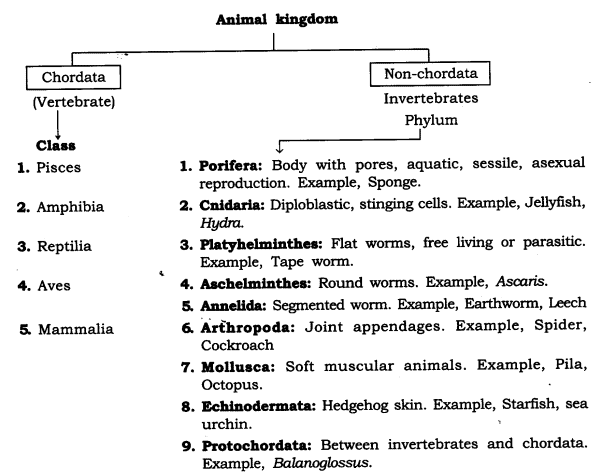
Value Based Questions
1: Many medicinal plants every year are getting extinct. A group of students who had gone for educational trip clicked photographs of endangered plants. These photograph were used by the school laboratory to study these plants.
(a) Name two endangered plants.
(b) Name any one medicinal plant and give its medicinal use.
(c) What value of students is reflected in the above act?
Answer:
(a) Two endangered plants are:
(i) Euphrasia
(ii) Ubnus rubra
(b) Aloe-vera. Juice of Aloe-vera is used in case of indigestion, treating dkin infection etc.
(c) Students are caring citizens, shows responsible behaviour.
2: Due to global warming coral is getting diminished in all the oceans/ water bodies. People in Lakshadweep island protects their corals by not allowing people/tourist to scape take few pieces away.
(a) Name the phylum of coral.
(b) What is coral made up of.
(c) What values of people in Lakshadweep island is reflected?
Answer: (a) Phylum of coral is coelenterata.
(b) Coral is made up of calcium carbonate.
(c) People in Lakshadweep island reflect the value of-being-responsible (Citizen, respecting environment and nature.